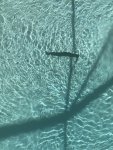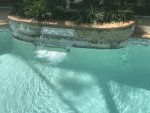Is this something I can do? Tile my whole pool that is.
- Thread starter FloridaLWR
- Start date
You are using an out of date browser. It may not display this or other websites correctly.
You should upgrade or use an alternative browser.
You should upgrade or use an alternative browser.
- Jul 21, 2013
- 65,253
- Pool Size
- 35000
- Surface
- Plaster
- Chlorine
- Salt Water Generator
- SWG Type
- Pentair Intellichlor IC-60
The size and direction of the cracks make me think you have a bigger problem then just delamination of the plaster. I think you may have structural problems with the gunite shell moving causing the cracking. You need to get to the root cause of your problems. Tile on a gunite shell with problems will not last and can become a bigger problem then what you have.
@onBalance may have thoughts if this is just a delamination problem.
@onBalance may have thoughts if this is just a delamination problem.
- Jun 7, 2017
- 9,975
- Pool Size
- 29000
- Surface
- Plaster
- Chlorine
- Salt Water Generator
- SWG Type
- Jandy Aquapure 1400
- Jul 21, 2013
- 65,253
- Pool Size
- 35000
- Surface
- Plaster
- Chlorine
- Salt Water Generator
- SWG Type
- Pentair Intellichlor IC-60
Pool Build in Costa Blanca Spain.
Having read all the construction blogs on here with some considerable envy our time has come to finally build a pool at our villa in Spain. The villa has been owned as a second/holiday home for about ten years. However we spent far less time than we wanted to due to work and other demands...
Materials for Tiling
Am considering tiling my diy pool (my-self-build-ferrocement-pool-t28358.html) and have been weighing up the likely costs and have a few questions if anyone could help please. Have been told that tiling on its own does not waterproof a pool. If epoxy grout is used, is this still the case? Due to...
I see this pool mainly having a delamination problem, as the plaster is simply falling off the walls without any bonding to the underlying surface.
However, the top step crack is a concern regarding structural or movements problems. But given the other more obvious delamination (bonding failure) situation, I think the contractor just didn't know how to properly perform quality work. I think a good contractor could redo this pool and make it work.
However, the top step crack is a concern regarding structural or movements problems. But given the other more obvious delamination (bonding failure) situation, I think the contractor just didn't know how to properly perform quality work. I think a good contractor could redo this pool and make it work.
2/3 years ago or somewhere in there. The warranty is useless.....Wow - when was the pool resurfaced? What was the warranty?
We called a couple of companies and they all said it was delamination, I think someone mention not using acid or doing some step before applying the resurfacing?I see this pool mainly having a delamination problem, as the plaster is simply falling off the walls without any bonding to the underlying surface.
However, the top step crack is a concern regarding structural or movements problems. But given the other more obvious delamination (bonding failure) situation, I think the contractor just didn't know how to properly perform quality work. I think a good contractor could redo this pool and make it work.
I can even understand something moving but wouldn’t I see it somewhere else as well? Something else cracked or broken?
This all started to happen when we turned on the water heater and then this blue thing started to come off very slowly from the sides, as it is now is is separated from the side like 5”. I wonder if there is something broken under the pool to make it move when the water heater is on? Could that be something like thT causing it?
- Jun 7, 2017
- 9,975
- Pool Size
- 29000
- Surface
- Plaster
- Chlorine
- Salt Water Generator
- SWG Type
- Jandy Aquapure 1400
First thing I would suggest is getting a professional in there to look at it and perhaps they'll want to chip the plaster off for a close inspection of the shell.
Given that this was an existing pool prior to the re-surfacing job and the pool (supposedly) did not have settlement or movement issues before, and that there is no loss of water, then I think that the movement and cracking issue can be ignored. But as PoolGate suggests, an experienced contractor may be able to help.
- Jul 21, 2013
- 65,253
- Pool Size
- 35000
- Surface
- Plaster
- Chlorine
- Salt Water Generator
- SWG Type
- Pentair Intellichlor IC-60
This all started to happen when we turned on the water heater and then this blue thing started to come off very slowly from the sides, as it is now is is separated from the side like 5”. I wonder if there is something broken under the pool to make it move when the water heater is on? Could that be something like thT causing it?
The water heater is not an invasive appliance. I don't see how it can cause that type of damage. It is likely coincidence.
You need to decide if you want to go the plaster or tile route to redo the pool. Either way the existing plaster has to be entirely removed before anything new can be applied. It does not provide a stable base for new material.
When the existing plaster is removed down to the gunite it can be examined for any cracking. Then it will become clear if the shell is good for the application of a new finish. Now being reminded that it is an old pool with a refinish the likelihood that the shell is moving is remote.
I think someone mention not using acid or doing some step before applying the resurfacing?
They probably did not put a bonding coat on the old plaster before they applied the new plaster. The bonding coat is like paint primer and improved the adhesion between the old material and the new material. Whoever does the work next needs to do the proper surface preparation.
There was a guy here several years ago - from Europe I believe - who tiled his own pool. And then he had to rip it all out and start over because the adhesive he used failed. He was extremely detail oriented and the pool was amazing.
Someone smarter than I can probably link his thread into here.
Concrete pool up north
hi there!! I have already made a few post in this beautyful site, that I've stumbled upon from a swedish poolforum a few days ago. I must say that I'm totally blown away by the projects you post in here. It's already yield us inspiration to add what you call a tanning ledge in one part of our...
ckendalls
Gold Supporter
- May 17, 2018
- 124
- Pool Size
- 11000
- Surface
- Plaster
- Chlorine
- Salt Water Generator
- SWG Type
- Hayward Turbo Cell (T-CELL-5)
Well, at least it may not be difficult to remove the bulk of bad plaster before sandblasting and prepping.... Can you share the name of the poor contractor?
MOD note: please use pm (conversation) for this information. Thank you.
MOD note: please use pm (conversation) for this information. Thank you.
Last edited by a moderator:
PM Sent.Well, at least it may not be difficult to remove the bulk of bad plaster before sandblasting and prepping.... Can you share the name of the poor contractor?
MOD note: please use pm (conversation) for this information. Thank you.
Well....given that the shell is coming off I can help it and remove it completely. I wonder if I can buy the same type of plaster that I already instead of buying tiles. I've read some things on the web but they said this is only sold to certified companies?
Can't catch a break on this thing.
Can't catch a break on this thing.
- Jun 7, 2017
- 9,975
- Pool Size
- 29000
- Surface
- Plaster
- Chlorine
- Salt Water Generator
- SWG Type
- Jandy Aquapure 1400
If you've ever seen them plaster a pool they have a large truck for the mixing and the spray it out of a nozzle. At least that is what they did on mine. Just mixing that amount of plaster without a machine would be a serious task!
If you've ever seen them plaster a pool they have a large truck for the mixing and the spray it out of a nozzle. At least that is what they did on mine. Just mixing that amount of plaster without a machine would be a serious task!
Thanks for that info, that is true, If I take this on my own I will have to rent a mixer because I won't be able to do it on my own.
Winger 03
Well-known member
- Sep 7, 2009
- 391
- Pool Size
- 19800
- Surface
- Fiberglass
- Chlorine
- Salt Water Generator
- SWG Type
- Pentair Intellichlor IC-30
Thanks zea3 - I wish he would have continued posting - it was an amazing build.
Concrete pool up north
hi there!! I have already made a few post in this beautyful site, that I've stumbled upon from a swedish poolforum a few days ago. I must say that I'm totally blown away by the projects you post in here. It's already yield us inspiration to add what you call a tanning ledge in one part of our...www.troublefreepool.com
Thanks for that info, that is true, If I take this on my own I will have to rent a mixer because I won't be able to do it on my own.
The mixer is the easy part. You also need a crew of several skilled plasterers because it all has to be applied nearly simultaneously or it will develop cracks where fresh plaster meets partially cured plaster. You're really better off hiring it out.
Tiling is an option, but requires tremendous skill on a pool with that shape, and the materials alone will cost more than paying someone else to replaster it.
If you want to save some money by doing some of the work yourself you could do the plaster chip out, surface prep, and waterline tile. Plaster chip out should be relatively easy considering how badly it's delaminating.
As onBalance mentioned, you may need some structural repair on the cracked step. It's not uncommon for pool builders to use rebound material from the gunite shoot to form the tops/edges of the steps, which results in very weak step edges and issues similar to what the pictures show there. Hard to say until you can get a good look at what's under the plaster though.
Jefina
New member
WHoa! ? that is bad. I too am thinking of tiling a small pool/pond, but it has no curves.
Last edited:
Jefina
New member
Oh my gosh! I read that whole thread last night and my heart just sank when he said the tiles started falling off. So terrible. I bet he never came back to the post because he had a nervous breakdown after that. Terrible.Thanks zea3 - I wish he would have continued posting - it was an amazing build.
Thread Status
Hello , This thread has been inactive for over 60 days. New postings here are unlikely to be seen or responded to by other members. For better visibility, consider Starting A New Thread.




